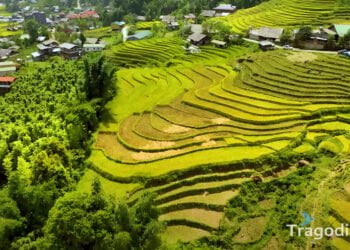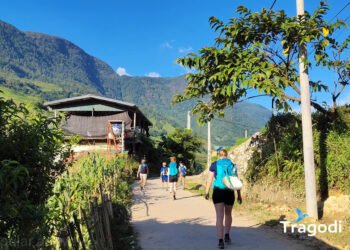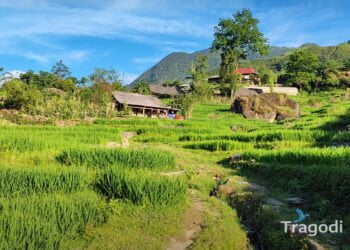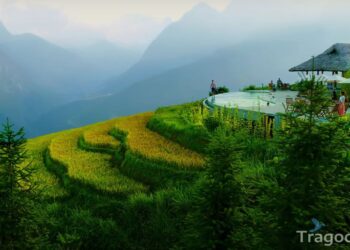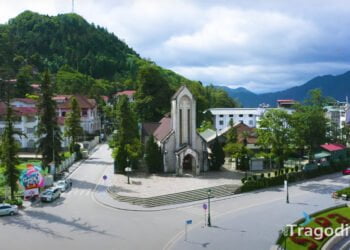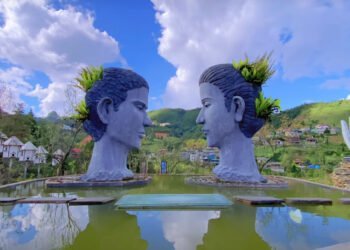1. Location an climate of Sapa
2. Best time to visit Sapa
3. How to get to Sapa
4. People, history and culture of Sapa
5. Accommodations in Sapa
6. Cuisine and specialties of Sapa
7. Tourist attractions in Sapa
8. Tours and activities in Sapa
1. Location an climate of Sapa
Sapa is a town located in the Northwest mountainous region of Vietnam, within Lao Cai province. The town sits at an average altitude of 1,500 to 1,800 meters above sea level, approximately 38 km from Lao Cai city and about 376 km from Hanoi. Sapa is a renowned tourist destination with numerous landmarks and traditional villages of ethnic minorities such as H’Mong, Dao, Tay, Giay, and Xa Pho.
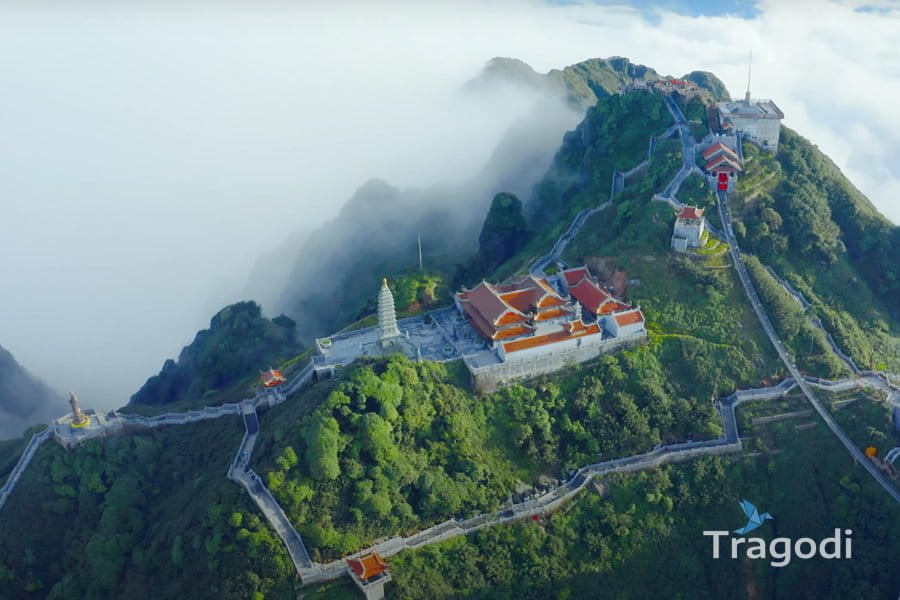
Sapa has a subtropical humid and temperate climate, with cool air all year round and an average temperature of 15°C. Sapa experiences four distinct seasons: Spring from February to April, Summer from May to August, Autumn from September to November, and Winter from December to January of the following year. Each season has its own unique beauty, from forests of plum and peach blossoms in the spring, to golden terraced fields in the autumn, and snow-covered mountains and forests in the winter.
2. Best time to visit Sapa
Sapa has four seasons, each with its own unique beauty, and depending on your preferences and purpose, you can choose the best time to visit.
Spring (from January to June): This is an ideal time for sightseeing, photography, and enjoying the distinctive cuisine of spring and summer. Sapa in spring is filled with the colors and fragrances of beautiful flowers, such as peach blossoms, orchids, milk flowers, and lotus…

Summer (from June to August): This is when Sapa becomes an ideal place to escape the heat, allowing visitors to immerse themselves in the cool, comfortable atmosphere of the temperate region. Especially, this is the time when farmers start planting, so visitors will have the opportunity to admire the sparkling terraced fields, forming the “mirrors” lying along the mountainside.
Autumn (from September to November): This is the most favorite time for many people, as Sapa at this time has a gentle, peaceful, and charming beauty. Autumn is also an occasion to explore the historical, cultural, and artistic relics of the capital. Sapa in autumn is also famous for the golden color of ripe rice, when Sapa seems to be wearing a shiny golden coat.
Winter (from December to February): This is when Sapa has an impressive cold climate, sunny days, and cold nights. This is also the only time of the year when you can watch snowfall in Sapa, creating a white, romantic, and magical scene.
3. How to get to Sapa
To get to Sapa, you have several options, depending on your preferences, needs, and budget. Here are a few options for your consideration:
By motorbike: You can drive a motorbike from Hanoi along one of two routes: The Hanoi through Vinh Phuc to Sapa (360 km) or the Hanoi through Hoa Lac to Sapa (370 km). This mode of transport is suitable for those who love to explore and experience.
By Limousine: You can book a Limousine ticket from Hanoi to Sapa on online ticket booking websites like Traveloka. Limousines are luxury vehicles with many services and amenities included. The travel time is about 5-6 hours to Sapa.

By train: You can take a train from Hanoi station to Lao Cai station, and then take a bus or taxi to Sapa. The train is a safe and convenient means of transport, with various types of carriages for you to choose from, from seats to beds. The travel time is about 8-9 hours.
By coach: You can take a coach from My Dinh bus station, Giap Bat bus station, or Nuoc Ngam bus station to Sapa. The coach is the most common and cheapest means of transport, but it can also be crowded and lack amenities. The travel time is about 6-7 hours.
By taxi: You can hire a taxi from Hanoi to Sapa on websites, car booking apps, or at your hotel. Taxis are a quick and comfortable means of transport, suitable for those traveling in small groups or families. The travel time is about 5 hours.
4. People, history and culture of Sapa
Sapa is not only famous for its majestic natural landscapes, but also as the home of many Vietnamese ethnic groups. Despite a turbulent history, Sapa has retained its unique and distinct cultural features, attracting tourists from all over the world.
Sapa is home to many ethnic minorities such as Kinh, Mong, Dao, Xa Pho, Tay, and Giay… They live in harmony in communities. Each ethnic group has its own physical characteristics, costumes, languages, customs, and beliefs, contributing to the diversity and richness of this land. The people of Sapa are hardworking, friendly, hospitable, and proud of their cultural identity.
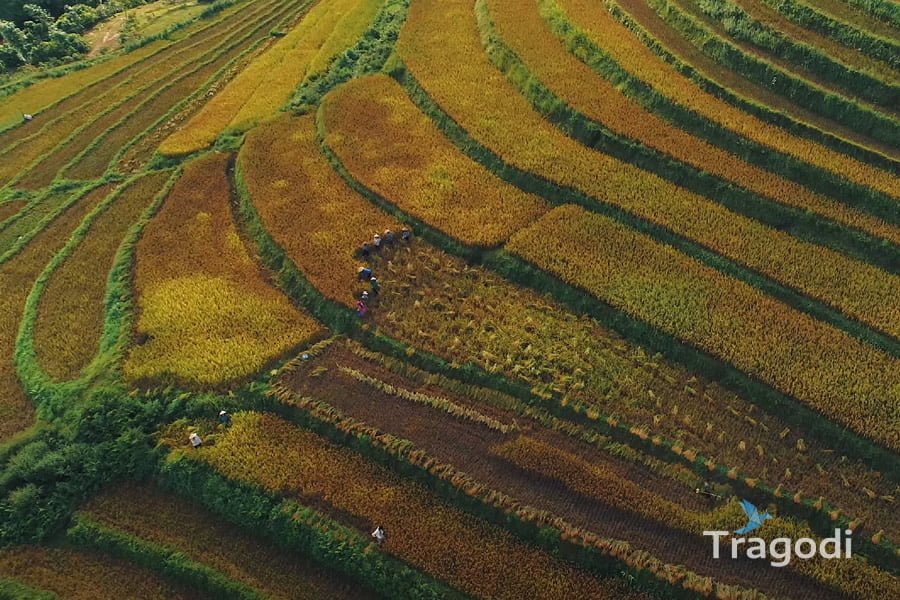
Sapa was discovered by the French at the end of the 19th century and became a famous resort at the beginning of the 20th century. Since then, Sapa has gone through many historical upheavals, from the resistance wars against France and the US, to the period of renovation and development. Today, Sapa is one of the most attractive tourist destinations in Vietnam, attracting millions of visitors each year.
Sapa preserves folk cultural heritage through festivals, arts, handicrafts, cuisine, and architecture. Notable festivals include the field descending festival, Gau Tao, Tet dance, village sweeping, and Sapa love market… Sapa’s art is rich with singing, dancing, and playing musical instruments… Handicraft products are made from cotton fabric, wool, wood, bamboo, stone… Sapa’s cuisine is a combination of specialty dishes such as pork, sticky rice, Thang Co, Men Men, corn wine… Sapa’s architecture blends classic French style with the traditional style of the ethnic people.
5. Accommodations in Sapa
To have an enjoyable, comfortable, and fulfilling trip, you need to choose a suitable accommodation that meets your needs and preferences. Here are some suggestions for accommodations in Sapa that you might consider:
If you want to enjoy luxury and convenience, you can choose high-end resorts such as Silk Path Grand Resort & Spa Sapa, Victoria Sapa Resort & Spa, or Amazing Sapa Hotel… These places have beautiful locations, spacious rooms, full amenities, and quality services.
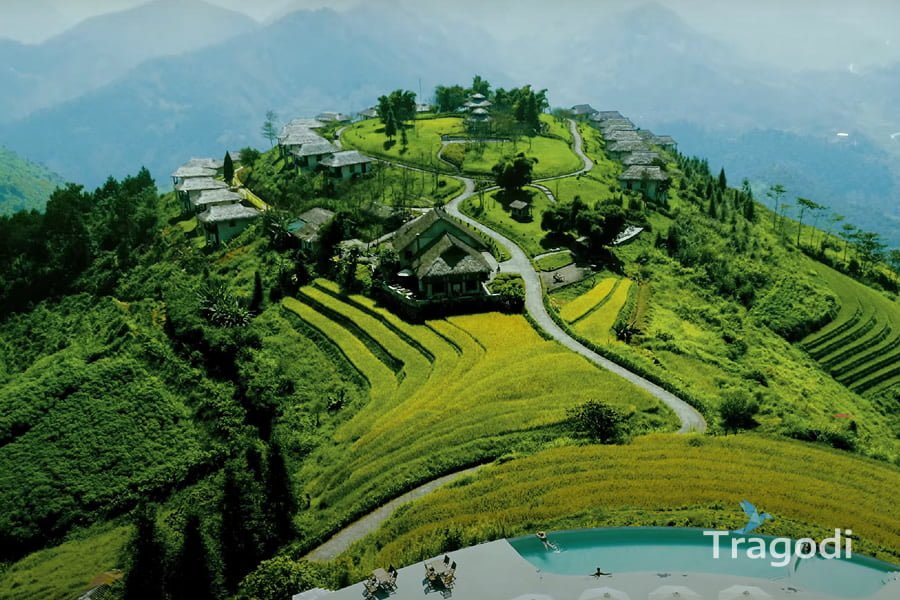
If you want to experience life close to nature and local culture, you can choose unique homestays like Topas Ecolodge, Sapa Jade Hill Resort & Spa, or The Mong Village Resort & Spa… These places have architecture characteristic of ethnic groups, located among valleys, tea hills, or pine forests, creating a peaceful and intimate space.
If you want to save costs and have convenient transportation, you can choose hotels in the town center like H’Mong Sapa Hotel, U Sapa Hotel, or Sapa Legend Hotel & Spa… These places have clean rooms, full basic amenities, beautiful views, and are close to the market, stone church, and eateries.
And many other attractive tourist attractions…
6. Cuisine and specialties of Sapa
Sapa has a diverse and rich culinary culture. The cuisine here is a harmonious combination of traditional dishes of ethnic minorities and modern dishes of the Kinh people. Here are some dishes and specialties of Sapa that you can refer to:
Salmon and sturgeon: These are two rare types of fish raised in Sapa, with firm, sweet, and nutritious meat. You can eat dishes from fish such as hotpot, grilled, steamed, fried, sauced or stir-fried…
Roasted piglet: This is a characteristic dish of the Hmong people, made from the piglet breed of the lang village, weighing only about 10kg. The pork is marinated with spices and then grilled over charcoal, it is delicious, crispy and not fat.

Smoked buffalo meat: This is a traditional dish of the Dao people, made from young buffalo meat cut into thin slices, marinated with salt, chili, ginger, garlic and then hung up in the kitchen to dry. Buffalo meat has a rich, sweet taste and a smoky aroma.
Thang Co: This is a specialty dish of the H’Mong people, made from parts of horses, cows, buffaloes… cooked with broth, fig leaves, coriander, onions, garlic, chili and many other spices. Thang Co has a rich, slightly spicy and fatty taste.
Sticky rice in bamboo tube: This is a rustic dish of the Tay people, made from sticky rice mixed with coconut milk and then put into a bamboo tube, grilled over fire. Sticky rice in bamboo tube has a sweet, rich taste, fragrant with bamboo and coconut, eaten with grilled meat or honey.
In addition, Sapa also has many other delicious dishes such as Bac Ha clean pho, stir-fried vegetables, grilled dishes, black chicken, seven-color sticky rice, forest fragrant mushrooms…etc.
7. Tourist attractions in Sapa
Sapa, with its majestic natural beauty, attracts tourists not only for its scenery but also for its unique attractions. Each place offers visitors different experiences, leaving a mark in their memories of their journey to Sapa. Here are some notable suggestions for you:
Sun World Fansipan Legend: This is an integrated resort, famous for its world-class cable car system, which helps you conquer the peak of Fansipan – the roof of Indochina. You can also visit the temples on the mountain top, such as Kim Son Bao Thang temple, Bich Van temple, and Buddha temple.

Muong Hoa Valley: This is the most beautiful valley in Sapa, highlighted by vast terraced rice fields, the gentle Muong Hoa stream, and the May bridge – a suspension bridge connecting the two banks of the stream. You can also visit the villages of ethnic minorities, such as Cat Cat village, Ta Phin village, and Lao Chai – Ta Van village.
Swing Sapa: This is a hot check-in point in Sapa, located in the town center, overlooking Hoang Lien Son National Park. You can try the adventurous feeling with the infinity swings, Buddha’s hand cloud hunting, stairway to the clouds, and many other unique photo corners.
Rong May Glass Bridge Sapa: This is the highest glass bridge in Vietnam, located at O Quy Ho pass, about 7km from the center of Sapa. You can experience the feeling of walking in the air, admiring the Hoang Lien Son mountain range and the terraced rice fields.
O Long Tea Hill: This is one of the most romantic tourist spots in Sapa, located in Ta Phin commune, about 15km from the center of Sapa. You can admire the lush tea fields, enjoy the special O Long tea, and learn about the life of the Red Dao people.
8. Tours and activities in Sapa
When you visit Sapa, you can participate in a variety of interesting and unique activities. Depending on your preferences and plans for the trip, you can engage in the following activities:
Exploring Nature: One activity you can’t miss is conquering the peak of Fansipan – the roof of Indochina, using the modern cable car system at Sun World Fansipan Legend. In addition, you can also visit temples on the mountain top, such as Kim Son Bao Thang temple, Bich Van temple, and Buddha temple. Another place worth mentioning is Muong Hoa Valley, famous for its vast terraced rice fields, an ideal destination for those who love nature and want to learn about the culture of ethnic minorities.

Cultural Experiences: Swing Sapa, a super hot check-in spot, is located in the town center, where you can try the adventurous feeling with the infinity swings and enjoy a panoramic view of Hoang Lien Son National Park. You can also visit the villages of ethnic minorities, such as Cat Cat village, Ta Phin village, and Lao Chai – Ta Van village… to learn about the life and culture of the local people.
Other Activities: Enjoying the cuisine to taste the characteristic flavors of the dishes and specialties here. Participating in cooking and sewing classes to learn more about Sapa’s culture. Visiting Sapa market to buy local handicraft products. Visiting other tourist spots such as Silver Waterfall, Cloud Bridge, O Long Tea Hill…
Sapa is an ideal place to experience a different life, with majestic landscapes and magnificent mountains. Nestled in the heart of Vietnam, Sapa is a treasure trove of spectacular natural beauty and diverse rich culture. You can explore Fansipan peak, where you can overlook the entire mystical land, or Muong Hoa valley, with its lush terraced fields and charming ethnic minority villages. You can also enjoy local cuisine, an attractive combination of flavors, and swing on the cloud swings at Swing Sapa. Sapa offers an unforgettable journey, allowing you to better understand the heart and soul of this land. Sapa is waiting for you, ready to reveal its secrets and create a unique travel story just for you.

